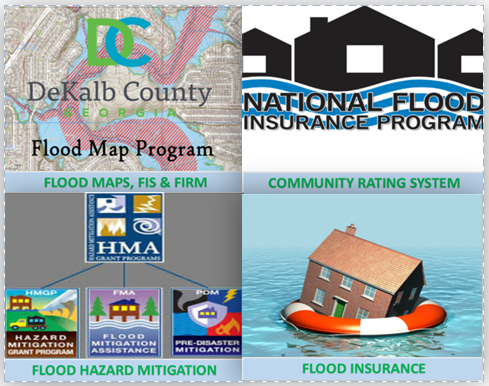Floodplain Management
 |
Oversees the National Flood Insurance Program (NFIP) and the Community Rating System (CRS) program that prevents flood damage and minimize community risk to life and property in DeKalb County.
National Flood Insurance (NFIP) Program
- Know the Risk: Click here to access DeKalb County flood map or click here to access FEMA Map Service Center.
- Mitigate the Risk: Understand regulations guiding developments in a floodplain, learn about substantial Improvement and substantial damage (SI/SD).
- Insure the Risk: Flood insurance is available in all NFIP participating community including DeKalb County. Click here for more information.
Community Rating System (CRS) Program
- A voluntary program that started in 1990.
- It recognizes floodplain management activities that exceeds NFIP minimum standard.
- Activities are grouped into. Public Information, Mapping and Regulation, Flood Damage Reduction & Warning and Response.
- DeKalb County officially joined on October 1, 1992.
- DeKalb County current Class Designation is Class 7 (15% discount on flood insurance premiums)
Flood Insurance Rate Map
- Official FEMA map of a community showing roads, landmarks & delineated risk zones.
- Contains a community's Base Flood Elevations (BFE), Flood Zones & Floodplain Boundaries.
- Click here to access DeKalb County FIRMs.
Flood Insurance Study (FIS)
- A compilation of flood risk data for specific watercourse, lakes etc. within a community.
- Contains detailed flood elevation data in profiles and tables.
- Click on these links for DeKalb County Effective Flood Insurance Study; Volumes 1, 2, 3, 4, 5, 6, 7, 8, 9, 10
Hazard Mitigation
- Sustained measures to reduce or eliminate long term risks to life and property from future disasters.
- Retrofitting is one of the measures used in hazard mitigation.
- Elevation - Raising the lowest floor or the lowest horizontal member to or above regulated flood level.
- Relocation - Moving the property to a higher ground to reduce exposure to flooding.
- Demolition - Removing affected property to build a compliant and resilient one.
- Floodproofing - There are two types; Dry floodproofing (structure and utilities are made watertight) & Wet floodproofing - allows floodwaters to enter a building through openings.
- Barrier Systems - These are flood wall or levees to restrain floodwater.
Flood Insurance
Flood insurance is mandatory if any of the following applies.
- Your mortgage is federally regulated or from an insured lender.
- You live in a high-risk flood zone and
- Received federal disaster assistance (grants) from FEMA
- Received low-interest disaster loans from the U.S Small Business Administration (SBA) following a Presidential Disaster Declaration.
Whether you are required to have flood insurance or not, learn about Risk Rating 2.0 and PROTECT YOURSELF AGAINST RISK.
Hazard Mitigation Assistance Program
- FEMA has three Hazard Mitigation Assistance grant programs.
- Hard Mitigation Grant Program (HMGP): Supports cost effective post-disaster planning and projects following a Presidential major disaster declaration.
- Flood Mitigation Assistance (FMA): Supports only planning and projects that reduces or eliminates long term risk of flood damage to structures insured under the NFIP.
- Building Resilient Infrastructure and Communities (BRIC): Supports building of capacity and capability of infrastructures towards community resilience.
- DeKalb County Home Buyout Program.
- FEMA-funded voluntary relocation from flood-prone-areas.
- 75% federal funding, 25% local cost share.
- Properties converted to permanent open space.
Quick Links
Streamflow Gage Locator | Flood Risk Snapshot | Risk Rating 2.0: Equity in Action | ||
| Homeowner's Guide to Retrofitting | How Do I Buy Flood Insurance Policy? |